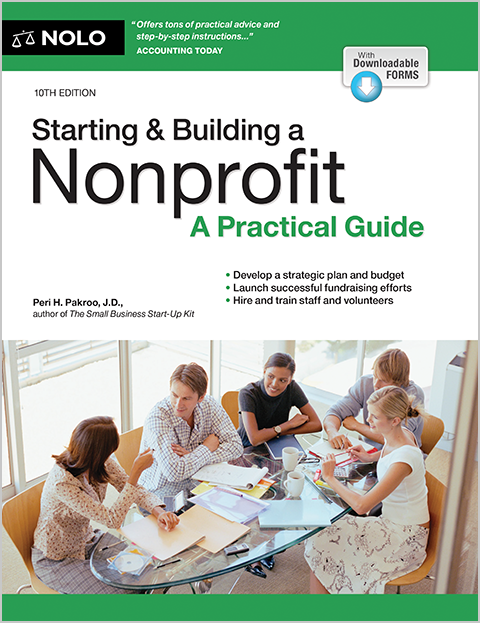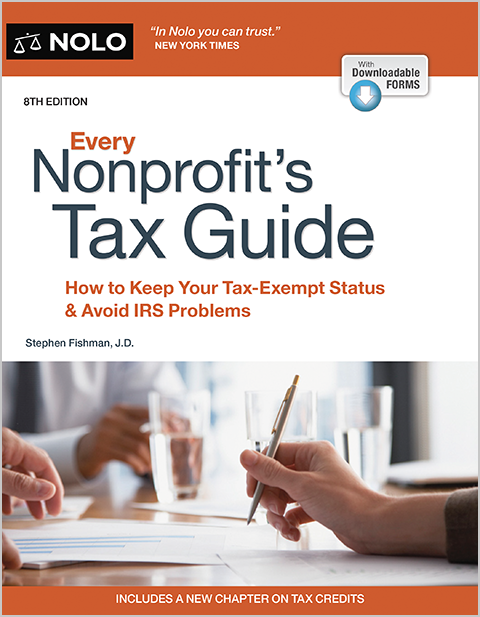Find out how to dissolve and wind up your California nonprofit public benefit corporation.
Need to close down your California nonprofit corporation? You'll need to follow California's dissolution laws for nonprofits. While a nonprofit can be involuntarily or administratively dissolved, we'll focus on voluntary dissolution. California recognizes three kinds of nonprofits. Most California nonprofits fall under the category of a nonprofit public benefit corporation—an eligible 501(c)(3) nonprofit corporation.
Here's a quick overview of the main steps to dissolve and wind up a nonprofit public benefit corporation under California law.
- 1. Authorize Your Nonprofit's Dissolution
- 2. File a Certificate of Election to Wind Up and Dissolve
- 3. Wind Up Your California Nonprofit Corporation
- 4. Receive Dissolution Waiver from the Attorney General
- 5. File a Certificate of Dissolution
- 6. Submit a Final Submission to the Attorney General
- Federal Tax Note for Nonprofits
- Streamlined Dissolution Procedure for Certain Eligible Nonprofits
- Additional Information for California Nonprofits
1. Authorize Your Nonprofit's Dissolution
To start closing your nonprofit, you'll need a resolution to wind up and dissolve. With the resolution in hand, California law provides for voluntary dissolution in one of three ways:
- by majority approval of your nonprofit's members
- by action of your nonprofit's directors followed by a vote or other consent of the members; or
- if your nonprofit doesn't have members, by a vote of the directors.
(Cal. Corp. Code § 6610 (2024).)
Under the first method, a majority of all the nonprofit's members must give their approval through a vote or written ballot.
Under the second method, the board generally will approve the resolution and then submit it to the members. The members then meet and vote to approve the dissolution.
Under the third method, the board alone approves the dissolution. Depending on the circumstances, this process could involve unanimous consent or a majority vote.
Make sure to properly record the resolution to wind up and dissolve, the directors' votes, and, where necessary, the members' votes or ballots. You'll need this information for filings with the state and the IRS.
2. File a Certificate of Election to Wind Up and Dissolve
After your nonprofit has formally decided to wind up and dissolve, you must "forthwith" file a Certificate of Election to Wind Up and Dissolve with both the Secretary of State (SOS) and the Attorney General (AG). The certificate must contain:
- a statement that the corporation has elected to wind up and dissolve
- if the election was made by the vote of members alone, a statement of the number of votes for the election and that the election was made by a majority of all members
- if the election was made by the board and members, a statement that it was made by the board and the members
- if the certificate is signed by a member or members, a statement that the signer or signers were authorized to execute the certificate by a majority of all members; and
- if the election was made by the board alone because there are no members, a statement indicating that fact.
(Cal. Corp. Code § 6611 (2024).)
How to File a Certificate of Election to Wind Up and Dissolve
You can file your certificate online through the SOS's bizfile Online system. If you incorporated your nonprofit corporation through the bizfile Online system, then you should already have an account for your nonprofit.
You can also file your certificate by mail. The SOS provides a nonprofit dissolution packet that you can download and fill out that includes:
- a Business Entities Submission Cover Sheet
- a Nonprofit Certificate of Election to Wind Up and Dissolve (Form ELEC NP), and
- a Nonprofit Certificate of Dissolution (Form DISS NP).
Make sure you include your cover sheet along with your certificate of election filing.
As of 2024, there's no fee to file a Certificate of Election to Wind Up and Dissolve.
Some Nonprofits Don't Need to File a Certificate of Election
Some nonprofit corporations aren't required to submit Form ELEC NP to the SOS and AG. If your election to dissolve is made by a unanimous vote of your members, or by a unanimous vote of your board if you have no members, then you don't need to file the Certificate of Election to Wind Up and Dissolve. But you'll still need to submit a Certificate of Dissolution (explained later).
3. Wind Up Your California Nonprofit Corporation
After your nonprofit has formally authorized dissolution, it continues to exist only for the purpose of taking care of certain final matters that, collectively, are known as "winding up" the organization. Your nonprofit must stop any activities that aren't necessary to close up the business. Winding up largely involves notifying people about your nonprofit's dissolution, paying off debts, and distributing assets.
Notifying the Nonprofit's Members, Creditors, and the Attorney General
As you begin the winding-up process, you'll need to notify parties of your nonprofit's decision to dissolve. Specifically, you must send written notice of the voluntary winding up by mail to the following groups:
- all of the nonprofit's members (except for the members who voted in favor of winding up and dissolving the nonprofit)
- any of the nonprofit's known creditors and claimants whose addresses are in the nonprofit's records, and
- the AG.
(Cal. Corp. Code § 6613 (2024).)
You can deliver notice of your nonprofit's dissolution to the AG's Registry of Charities and Fundraisers in care of the Dissolution Program by mail or in person.
Paying Off Debts and Making Plans to Distribute Remaining Assets
Generally speaking, you can only distribute money and property after you've paid off all of your nonprofit's debts. These debts could include taxes, loan payments, and unpaid rent. While you don't need to receive clearance from the FTB, you still need to make sure your nonprofit has paid all of its taxes and filed its final returns.
After paying off debts, a dissolving 501(c)(3) organization must distribute its remaining assets for tax-exempt purposes. In practice, this task usually means distributing assets to one or more other 501(c)(3) organizations. However, other asset distribution requirements—such as returning loaned items to the lender—might also apply.
At this point, you should decide:
- which organizations will receive your nonprofit's assets
- which assets the recipient nonprofits will receive
- how the recipient organization must use these assets, and
- on what date you'll distribute the assets.
But it's critical that you don't yet distribute these assets. Because your nonprofit was organized for a specific purpose, the AG can object to any distributions your nonprofit makes that are inconsistent with your nonprofit's purpose. So, before you distribute your nonprofit's remaining assets, you must receive a dissolution waiver of objections from the AG (discussed below). (Cal. Corp. Code § 6716 (2024).)
If your nonprofit doesn't have any remaining assets, then you won't need to make plans for its assets. However, you'll still need to obtain a dissolution waiver from the AG.
4. Receive Dissolution Waiver from the Attorney General
Regardless of whether your nonprofit has any remaining assets after all its debts are paid, you must request a letter from the AG that "either waives objections to the distribution of the corporation's assets... or confirms that the corporation has no assets." Both public benefit and religious nonprofits must meet this requirement.
You must request the letter by sending the following documents to the AG:
- a letter signed by a director or the nonprofit's attorney with information about the intended recipients of any assets (or, if no assets remain, information regarding that fact)
- a signed copy of your Certificate of Dissolution prepared for submission to the SOS
- a copy of your Certificate of Election to Wind Up and Dissolve
- copies of your nonprofit's IRS Form 990, Form 990-EZ, or Form 990-PF for the last three accounting periods; and
- an endorsed-filed copy of your nonprofit's articles of incorporation, including any amendments.
Once you receive your letter, hold on to it. When you submit your Certificate of Dissolution to the SOS, you'll need to include the AG's letter.
5. File a Certificate of Dissolution
After you've completed the winding-up process for your nonprofit, you must file a Certificate of Dissolution with the SOS. A majority of your nonprofit's directors must sign and verify the certificate. The Certificate of Dissolution must include the following information:
- the name of your nonprofit
- a statement that the nonprofit's known debts and liabilities have been paid or adequately provided for, or paid or adequately provided for as far as the assets permit, or that the nonprofit has incurred no known debts or liabilities.
- a statement that the nonprofit has been completely wound up and is dissolved, and
- a statement that all required final returns have been or will be filed with the FTB.
As discussed earlier, you must also include a letter from the AG waiving objections to the proposed distribution of your nonprofit's assets or confirming that your nonprofit has no assets to distribute. (Cal. Corp. Code § 6615 (2024).)
You can fill out and submit a dissolution packet by mail or complete the filing online using the SOS's bizfile Online system.
After the SOS approves your filing, they'll send you back a stamped copy of the Certificate of Dissolution.
6. Submit a Final Submission to the Attorney General
To complete the closing of your nonprofit, you must mail a final dissolution packet to the AG. The packet should contain:
- a copy of the stamped certificate of dissolution you received back from the SOS, and
- the final financial report for your nonprofit showing proper distribution of all assets resulting in a zero balance.
This is the final step to dissolve your nonprofit with the state. You'll need to take other steps to close your nonprofit out with the IRS.
Federal Tax Note for Nonprofits
For federal tax purposes, you must file IRS Form 990 or IRS Form 990-EZ to close out your nonprofit's existence with the federal government. With your final tax form, you must include:
- a completed Schedule N (Liquidation, Termination, Dissolution, or Significant Disposition of Assets)
- a copy of your Certificate of Dissolution, and
- a copy of your nonprofit's resolution to wind up and dissolve.
When completing Form 990 or Form 990-EZ, you must check the "Terminated" box in the header area on Page 1 of the return.
For additional guidance, check out Every Nonprofit's Tax Guide, by Stephen Fishman (Nolo), or the instructions on the IRS's termination of an exempt organization webpage. If you have further questions, consider consulting with a tax professional.
Streamlined Dissolution Procedure for Certain Eligible Nonprofits
In certain limited circumstances, nonprofits might be eligible to dissolve using a streamlined dissolution procedure in California. In general, only nonprofits "created in error" that have existed for 24 months or less can use the Nonprofit Short Form Dissolution Certificate (Form DSF NP).
A majority of the nonprofit's directors—or the incorporator or a majority of incorporators if no directors were elected or listed in the articles of incorporation—must sign and verify the short for dissolution certificate.
The person filing the certificate must be able to state that:
- the certificate of dissolution is being filed within 24 months of the date the nonprofit's articles of incorporation were filed
- the nonprofit doesn't have any outstanding debts or other liabilities, other than tax liabilities, and all existing tax liabilities will be satisfied or be assumed by another individual or entity
- a final franchise tax return has been or will be filed with the FTB
- the nonprofit was created in error
- the known assets of the nonprofit remaining after paying any known debts or liabilities have been distributed as required by law or the nonprofit doesn't have any known assets
- a majority of the directors—or, if no directors have been elected or named, the incorporator or a majority of incorporators—has authorized the dissolution and elected to wind up the nonprofit
- the nonprofit hasn't issued memberships (and has returned any payments it received for memberships), and
- the nonprofit is dissolved.
(Cal. Corp. Code § 6610.5 (2024).)
You must file the certificate with the SOS. The SOS will notify the FTB and AG of your nonprofit's dissolution. After filing this form, the state effectively dissolves your nonprofit is effectively dissolved by the state.
Additional Information for California Nonprofits
Before you start the dissolution process for your nonprofit, you should refer to the dissolution webpage on the AG's website. This page has a summary of the voluntary dissolution process, a list of the relevant laws, and answers to FAQ. You should also check out the AG's General Guide for Dissolving a California Nonprofit Corporation. This guide gives you step-by-step instructions for dissolving your nonprofit, including what documents you need to submit and what agencies to contact.
This article covers only the most basic steps of voluntary dissolution after your nonprofit has started doing business. There are many additional, more specific rules, covering things like:
- involuntary dissolution
- dissolution of non-typical nonprofits (for example, mutual benefit corporations)
- giving proper advance notice of member and director meetings
- court-supervised winding up of a nonprofit
- what specific information needs to be included in notices to members, creditors, and the AG
- filing final state tax returns
- petitioning a court rather than filing a certificate of dissolution
- how to dispose of known claims against a nonprofit through written notice; and
- how to respond to claims against the nonprofit after dissolution.
In addition, your articles of incorporation or bylaws might contain rules that apply instead of, or along with, state law. You're strongly encouraged to consult with a lawyer to obtain additional information on these and other points related to your nonprofit's dissolution and winding up.
Dissolving and winding up your nonprofit corporation is only one piece of the process of closing your organization. For further, general guidance on many of the other steps involved, check out our 20-point checklist to closing your business and our article on what you need to do when closing your business.
- 1. Authorize Your Nonprofit's Dissolution
- 2. File a Certificate of Election to Wind Up and Dissolve
- 3. Wind Up Your California Nonprofit Corporation
- 4. Receive Dissolution Waiver from the Attorney General
- 5. File a Certificate of Dissolution
- 6. Submit a Final Submission to the Attorney General
- Federal Tax Note for Nonprofits
- Streamlined Dissolution Procedure for Certain Eligible Nonprofits
- Additional Information for California Nonprofits



